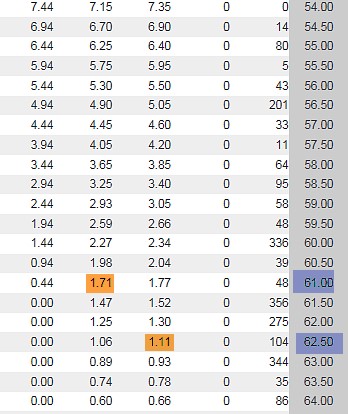Covered call writers, historically, have ignored exit strategies as part of their investment approach. Certainly, not in the BCI community but most everywhere else. As we become aware of the major financial benefits of mastering the position management skill, we must be mindful of the possibility of over-management. Eating a slice of pizza is enjoyable, eating a whole pie can be painful. In this column we will evaluate the frequency with which we should roll down when one of our securities is declining in value. My thanks to Alan P., one of our premium members, for inspiring this article.
Alan’s trade
- 8/16/2016: Buy NVDA at $63.18
- 8/16/2016: Sell the 9/9/2016 $62.50 call at $2.00, a 2.1% initial return with 1.1% of downside protection of that option profit

NVDA Calculations for Initial Returns using The Ellman Calculator
- 8/17/2016: Market downturn and NVDA trading at $61.15 (near breakeven)
- 8/17/2016: Option premium at $1.08, 54% of original sale price and not close to our 20% guideline
We’re at breakeven…why not roll down every time we reach breakeven?
On initial glance, it may appear too good to be true that every time we reach breakeven, we can roll down and generate option credits and continue to pile up premium profits. Intuitively, we all know that nothing is too good to be true when it comes to investing in the long-term and that there are no free lunches. If there were, I’d want to meet the folks who are constantly taking the other side of our 100% winning trades and thank them…they don’t exist except maybe in the fantasy world of those 3 AM infomercials (don’t get me started!). Our initial takeaway is that we know rolling down will allow us to generate option credits and that this is an invaluable exit strategy in our arsenal.
BCI guidelines for rolling down: 20%/10% guidelines
- We buy back the option in the first half of the contract when option value reaches 20% or less of the original premium generated and 10% or less in the latter part of a contract
- Rolling down is generally reserved for the latter half of a contract
Disadvantages of constant rolling down when breakeven is reached
This is where understanding the trade execution process and the option Greeks (factors that influence option premium) will put cash into our pockets. Let’s have a look at the options chain on 8/17/2016 when option value is at 54%, NOT 20%, and the initial trade is near breakeven ($61.15):

NVDA-Options Chain for Rolling Down
The option chain clearly shows the advantage of rolling down from the $62.50 strike to the $61.00 strike, an option credit of $0.60 ($1.71 – $1.11) representing an additional 1%, 3-week return. Now, let’s dig a little deeper using our knowledge of trade executions and the option Greeks to identify the risks in rolling down in these scenarios.
Paying the difference in the bid-ask spread multiple times
We always buy at the ask (higher price) and sell at the bid (lower price). The difference is pocketed by the market-makers and paid for by us. We must temper and be selective as to how frequently and when we pay the spread to these market-makers.
Multiple commissions add up
We should be using online discount brokers to minimize trading commissions but we certainly should not be that kind to our brokers to initiate trades that do not benefit us.
***Locking in greater stock loss every time we roll down
Selling the original call meant that the shares could be worth no more than $62.50 during the contract. By rolling down, shares can be worth no more than $61.00. We cannot ignore the stock side of our trades. If share price rises, we will have to pay for share appreciation in the form of option intrinsic value to capture that rebound. Had we not rolled down, that recovery would be realized.
Theta effect
Every time we roll down and contract time passes, Theta is eroding option premium time value thereby decreasing opportunities to mitigate losses. This is why I generally reserve rolling down to the latter part of a contract.
Discussion
Rolling down is a key exit strategy in our arsenal but, like all strategies, it has its pros and cons. No free lunches and nothing is too good to be true….it wouldn’t be fair to those on the other side of our trades. But we can certainly be better and smarter than most! Understanding the positives and negatives will guide us to a management approach that will allow us to maximize our investment returns.
For more detailed information on rolling down:
New file in premium member area
“Strike Price Selection Guidelines” has been uploaded to the “resource/downloads” section (right side) of your member site. This will assist our members in determining which strike price to select based on market assessment, chart technicals and personal risk tolerance.
Market tone
Global stocks ticked up this week supported by continued improvement in manufacturing and solid US employment figures. West Texas Intermediate crude rose to $54.10 per barrel from $53.10 on increased tensions between the United States and Iran following an Iranian missile test. Volatility, as measured by the Chicago Board Options Exchange Volatility Index (VIX), rose to 10.97 from 10.8 last week. This week’s reports and international news of importance:
- The January employment report showed a 227,000 rise in payrolls
- This was muted by a downward revision from 204,000 to 164,000 in November
- Wages rose only 2.5% year over year in January, compared with 2.9% in December.
- The unemployment rate ticked up to 4.8% in January from 4.7% in December, though the labor participation rate rose to 62.9% from 62.7% a month.
- The United Kingdom’s parliament voted overwhelmingly in favor of advancing a bill to begin the Brexit negotiation process. Prime Minister Theresa May has set a 31 March deadline for invoking Article 50.
- While the US Federal Reserve left monetary policy unchanged at its first meeting of 2017, the Federal Open Market Committee noted improved measures of consumer and business confidence of late. The market has been reducing rate hike expectations in recent weeks. Just less than two 25-basis-point hikes are expected in 2017, down from expectations of three shortly after the Fed raised rates in December.
- President Donald Trump scolded major trading partners for manipulating their currencies. China, Japan and Germany were all named, resulting in currency market volatility.
- Based on preliminary Q4 gross domestic product figures, the eurozone grew 1.7% in 2016, compared with 1.6% for the US. That’s the first time the eurozone has grown faster than the US since 2008. Eurozone joblessness fell to a seven-year low in 2016, while consumer prices rose 1.8% versus a year ago, reflecting rebounding oil prices.
- Purchasing managers’ indices showed continued improvement in global manufacturing. The United States, the United Kingdom, Japan, China and the eurozone all reported solid manufacturing sentiment in January, though service-sector sentiment slowed mildly.
- President Trump is expected to sign an executive order on Friday that establishes a framework for scaling back the Dodd-Frank financial reform law enacted in the wake of the global financial crisis.
THE WEEK AHEAD
MONDAY, February 6th
- None scheduled
TUESDAY, February 7th
- Foreign trade deficit Dec
- Consumer credit
WEDNESDAY, FEB. 8th
- None scheduled
THURSDAY, FEB. 9th
FRIDAY, FEB. 10th
- Consumer sentiment index
- Federal budget
For the week, the S&P 500 was up by 0.12% for a year-to-date return of 2.61%.
Summary
IBD: Market in confirmed uptrend
GMI: 6/6- Buy signal since market close of November 10, 2016
BCI: I am currently fully invested and have an equal number of in-the-money and out-of-the-money strikes. Despite all the bullish signals, I have a neutral to slightly bearish overall market assessment due to concerns about the new administration’s economic policies and their potential negative impact on our stock market. Although more clarity is needed, I choose to take a defensive posture at this point in time.
WHAT THE BROAD MARKET INDICATORS (S&P 500 AND VIX) ARE TELLING US
The 6-month charts point to a neutral to slightly bullish outlook. In the past six months, the S&P 500 was up 6% while the VIX (10.97) declined by 15%.
